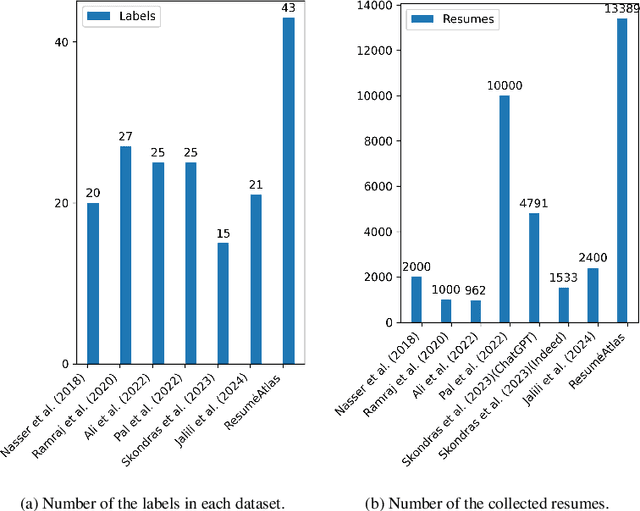Ahmed Zaky
ResumeAtlas: Revisiting Resume Classification with Large-Scale Datasets and Large Language Models
Jun 26, 2024

Abstract:The increasing reliance on online recruitment platforms coupled with the adoption of AI technologies has highlighted the critical need for efficient resume classification methods. However, challenges such as small datasets, lack of standardized resume templates, and privacy concerns hinder the accuracy and effectiveness of existing classification models. In this work, we address these challenges by presenting a comprehensive approach to resume classification. We curated a large-scale dataset of 13,389 resumes from diverse sources and employed Large Language Models (LLMs) such as BERT and Gemma1.1 2B for classification. Our results demonstrate significant improvements over traditional machine learning approaches, with our best model achieving a top-1 accuracy of 92\% and a top-5 accuracy of 97.5\%. These findings underscore the importance of dataset quality and advanced model architectures in enhancing the accuracy and robustness of resume classification systems, thus advancing the field of online recruitment practices.
Arabic Handwritten Text for Person Biometric Identification: A Deep Learning Approach
Jun 01, 2024Abstract:This study thoroughly investigates how well deep learning models can recognize Arabic handwritten text for person biometric identification. It compares three advanced architectures -- ResNet50, MobileNetV2, and EfficientNetB7 -- using three widely recognized datasets: AHAWP, Khatt, and LAMIS-MSHD. Results show that EfficientNetB7 outperforms the others, achieving test accuracies of 98.57\%, 99.15\%, and 99.79\% on AHAWP, Khatt, and LAMIS-MSHD datasets, respectively. EfficientNetB7's exceptional performance is credited to its innovative techniques, including compound scaling, depth-wise separable convolutions, and squeeze-and-excitation blocks. These features allow the model to extract more abstract and distinctive features from handwritten text images. The study's findings hold significant implications for enhancing identity verification and authentication systems, highlighting the potential of deep learning in Arabic handwritten text recognition for person biometric identification.
Advancing Ear Biometrics: Enhancing Accuracy and Robustness through Deep Learning
May 31, 2024Abstract:Biometric identification is a reliable method to verify individuals based on their unique physical or behavioral traits, offering a secure alternative to traditional methods like passwords or PINs. This study focuses on ear biometric identification, exploiting its distinctive features for enhanced accuracy, reliability, and usability. While past studies typically investigate face recognition and fingerprint analysis, our research demonstrates the effectiveness of ear biometrics in overcoming limitations such as variations in facial expressions and lighting conditions. We utilized two datasets: AMI (700 images from 100 individuals) and EarNV1.0 (28,412 images from 164 individuals). To improve the accuracy and robustness of our ear biometric identification system, we applied various techniques including data preprocessing and augmentation. Our models achieved a testing accuracy of 99.35% on the AMI Dataset and 98.1% on the EarNV1.0 dataset, showcasing the effectiveness of our approach in precisely identifying individuals based on ear biometric characteristics.
 Add to Chrome
Add to Chrome Add to Firefox
Add to Firefox Add to Edge
Add to Edge